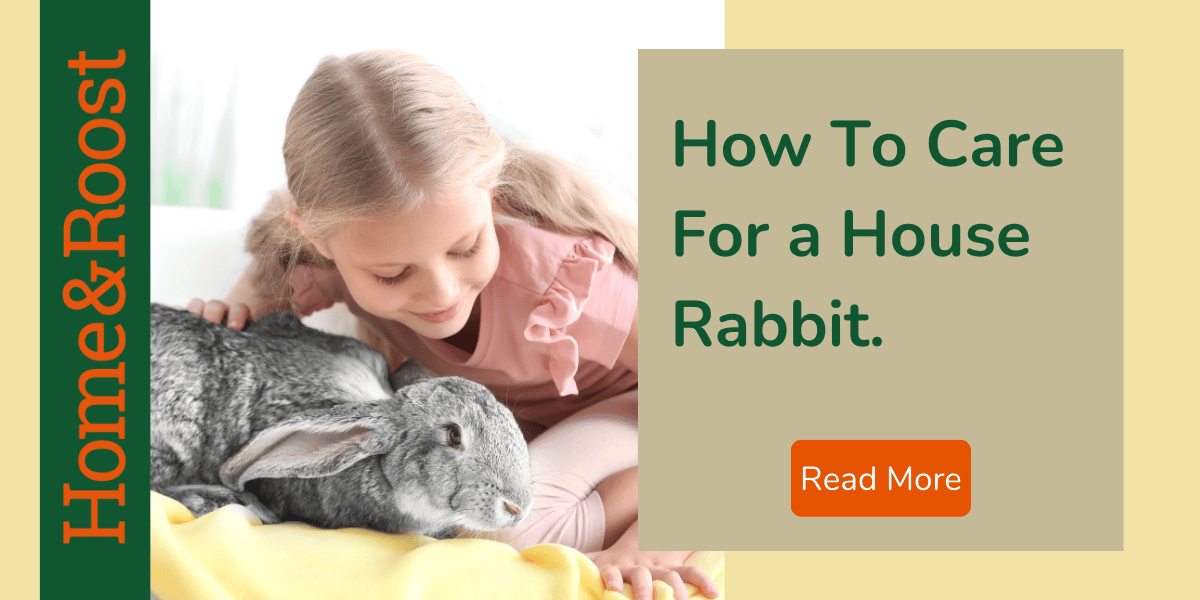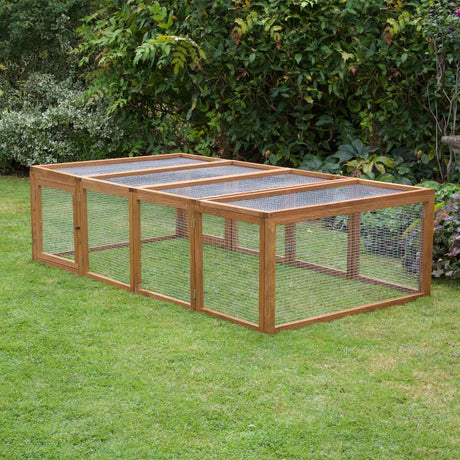There are few more divisive questions in the rabbit keeping community than whether to house pet rabbits indoors or out. Unsurprisingly, there are sound arguments to be made on both sides. Here at Home & Roost, we devote a lot of time to the needs of outdoor rabbits, but we believe that house rabbits can live happily too, as well, provided their needs are met.
Do Rabbits make Good House Pets?
Under the right circumstances, absolutely!
An indoor bunny has the same needs as outdoor rabbits do, in terms of living space, exercise, socialization, and so forth. At the same time, when it comes to fulfilling those needs, there are a few differences to keep in mind.
Cleanliness
Rabbits are very clean animals, but even the cleanest pets urinate and defecate regularly. Indoors, the smell can become overpowering if you're not on top of it.
Rabbits can learn to use a litter box, and many prefer to. Litter training your indoor rabbits and cleaning out the litter trays daily will go far toward keeping both you and your rabbits happy with the arrangement.
Chewing
Rabbits love to chew, and most rabbits will chew anything in sight. They may chew furniture, carpeting, skirting boards, cords and cables, and lots of other things you might not expect. Many of these things can be toxic, not to mention the damage to the objects themselves. We'll talk more in a bit about how to rabbit proof your indoor spaces.
Noise
Rabbits are prey animals and are sensitive to loud noises. At the same time, they want to be part of the family. It's important to choose the location for your rabbit's indoor enclosure with this balance in mind.
The Pros and Cons of Keeping Rabbits Indoors

As we said, this is a divisive question. Here are some of the arguments you might encounter on both sides.
Safety
Indoor rabbit owners argue that rabbits kept inside are safer from predators, weather extremes, parasites, and disease. This is true.
At the same time, indoor rabbits are subject to other dangers, which may include toxic chemicals, materials, and house plants; other pets, noise and disturbance, and inadequate exercise.
The upshot is that no matter where your rabbits live, it's important to be mindful of the risks, and to take the necessary steps to protect your bunnies.
Exercise
Speaking of exercise, pet rabbits need a lot of it, whether they live inside or out. The great news is that you can provide your pet rabbit with play and exercise just as easily inside as outdoors. In fact, many people give their bunnies all-day access to a bunny proofed room, just as an outdoor rabbit has access to a run.
Just because a rabbit lives indoors doesn't mean it can never go outside. In fact, many indoor rabbits love to have outdoor time in a secure area of your garden. PDSA recommends giving both outdoor and indoor rabbits daily access to a predator-proofed, escape proof outdoor run.
Socialization
Both indoor rabbits and outdoor rabbits need the company of other rabbits, and of people. One advantage of keeping an indoor rabbit is that it's very easy for an indoor rabbit to be part of the family.
Locate your rabbit's hutch , exercise pen, or enclosure in a place where people regularly gather. Many rabbits enjoy "watching TV" with their families, for example, from the safety of a puppy pen.
Do Some Rabbit Breeds Make Better House Rabbits?

It goes without saying that it requires less space to house smaller breeds indoors. At the same time, different breeds have different activity levels. The Mini Lop, for example, requires a lot of exercise, as opposed to the much more mellow Flemish Giant. And different individuals may prefer to live either indoors or outside.
If you're trying to decide whether your new friend should be a house rabbit or an outdoor bunny, ask yourself the following:
- Is your rabbit a highly active breed?
- Is this individual accustomed to living either indoors or outdoors?
- Which option would provide the most living space?
- Which option gives your rabbit the best opportunity for regular exercise?
- Will you spend more time with an indoor or an outdoor rabbit?
Bunnies are individuals, and although we can make some generalizations about breeds, it will ultimately come down to what works best for you and your bun.
Potential Risks for Indoor Rabbits

Although many house rabbits live long, happy lives, it's important to understand the household hazards that house rabbits face, including:
- Ingesting harmful substances (carpet fibers, cords and cables, cleaning solutions, etc.)
- Other house pets
- Poisonous house plants
- Noise and disruption
- Becoming trapped under furniture
- Being stepped on
- Escape
- Electrocution (from chewing cords and cables)
- Damaging furniture and / or flooring
Protect your house and your house rabbit by restricting your bun to certain thoroughly rabbit proofed areas of the house.
House Rabbits 101

A house rabbit has the same needs that an outdoor rabbit has. The difference is in how you fulfil those needs.
Living Space
No matter where your bunny lives, it will need a living space that is at minimum large enough for your house rabbit to stand up on its hind legs without touching the ceiling with its ears, stretch out on the floor, and hop three times from end to end.
PDSA recommends a minimum of 3 metres by 2 metres by 1 metre (10 ft x 6 ft x 3ft) of living space for a pair of rabbits -- and this doesn't include exercise space.
Your house rabbit's enclosure should have everything it needs, including water, a litter tray, toys, and unlimited high quality feeding hay.
Litter Training
A litter trained rabbit will save you a lot of trouble. It's not difficult, either.
First, make sure there are enough litter pans in the enclosure. If you have more than one rabbit, they may each want their own. Place the pans in the area where your rabbit naturally does its business; this will show your bun the purpose of the litter box.
Line the litter pan with high quality paper filler or wood shavings. You can also use hay, shredded newspaper, or shredded cardboard. Do not use clay cat litter, as it can harm or kill your rabbit. Add a bit of your rabbits soiled bedding to the litter to further reinforce the message.
Once your rabbit is reliably using the litter tray, keeping it clean is your job. Empty it at least once daily to keep your indoor rabbit area smelling clean and fresh.
Socialization

Most rabbits are unhappy living alone. Whether your bun lives indoors or out, we agree with welfare organizations that it will need a rabbit friend.
At the same time, house rabbits are in an excellent position to get lots of face time with their humans. Keep your house rabbits in a part of the house where people pass by regularly and can say "hi" several times a day. Also make opportunities for your indoor buns to spend family time with the family.
Mental Stimulation
In addition to a bunny buddy and plenty of time with its humans, your indoor bun should have access to lots of toys and boredom busters to keep their active minds happy. Toys can be as simple as a cardboard box or as complicated as a deluxe food puzzle.
The important thing is that your indoor bun can practice its natural behaviours, including:
- Digging
- Chewing
- Running
- Jumping
- Foraging
An indoor environment is less conducive to these behaviours, which means that you'll have to create opportunities for your bunnies to engage in them.
Taking time to actively play with your rabbit is a great way to provide exercise, socialization, and mental stimulation at the same time.
Exercise
Exercise is vital to your rabbit's health, indoor or out. Indoor buns, like their outdoor counterparts, should have all-day access to a generous and safe exercise space. And with a little bit of rabbit proofing, you can do this easily.
First, decide where your rabbits' exercise area will be. Many people rabbit proof an entire room and give their bunnies the "run" of it. Some rabbit proofing measures you might consider include:
- Removing, covering, or securing cords and cables
- Removing carpets
- Covering skirting and baseboards
- Covering wooden furniture legs
- Removing access to poisonous plants
- Protect upholstery
Also be aware that rabbits may burrow up into furniture from beneath and make nests in it, so block off the area beneath furniture so your rabbits can't get to it.
Alternately, you can create an enclosed exercise space using a puppy pen.
Food

Indoor and outdoor rabbits have the same dietary needs.
Specifically, all bunnies need unlimited access to water and high quality feeding hay. This should make up the majority of your bunny's diet. In addition, fresh vegetables are very good for your rabbit. Many rabbits also enjoy a small amount of high quality pellets.
It may be tempting to spoil your buns with treats, but remember, treats should make up no more than ten percent of your bunny's diet.
Keep Your Rabbit Happy Inside or Out
Can rabbits live as happily inside as they can outdoors? We think so! Indoor buns and outside rabbits have the same needs for food, shelter, exercise, socialisation, and safety. At the same time, you may have to think a bit differently about how you provide these things.
Do your rabbits live inside or out? Why? Join the conversation!








